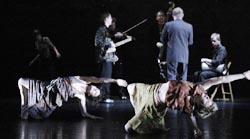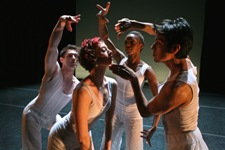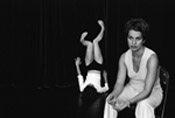“Quarantaine 4×4” is that happy experience in the theatre where you leave feeling full, uplifted. The show boasts rich and rewarding material, and though like most shows it needs to be snipped in places, it nonetheless has been honed and delivers engaging performances from its accomplished cast. The dancers do some dancing, but best of all, they’re intimate and up-close, delivering monologues, singing, sounding, and generally sounding off, in a production that’s very soulful.
Celebrated vocalist, composer and percussionist Charmaine LeBlanc decided a few years back to mount an evening-length work that addressed the idea of performers in their forties. That first show, merging dance, music, and a strong visual element, was produced by Danse-Cité in its Hors-Sentiers series (which brings together artists from different disciplines). It focussed on a rich quartet of female performers — AnneBruce Falconer, Jane Mappin, Mathilde Monnard and Carol Prieur. Comparisons are to be made. The big difference between that production and this latest male version of the concept, again produced by Danse-Cité, is that the guys — Marc Béland, Marc Daigle, Benoît Lachambre and Ken Roy — seem so game. They also appear to be having a ball; at least it seems so most of the time. I recall that wasn’t the case with the women, who often seemed concerned and contained in their revelations, and terrified at singing.
There’s an iffy line in asking a dance artist to vocalize, and then hoping to make them sound natural. But ultimately, as LeBlanc ably demonstrates, it’s not about singing well, it’s about how the artist can liberate his voice, or use it differently, and bring emotion out. That’s what we, in the audience, respond to, in part because we don’t have expectations otherwise. Thematically, in the earlier production and this new one, the dancers grapple with ideas about love, life, sex and relationships, and they probe uncertainties about fading youth and the onset of age.
The male “Quarantaine” is essentially an intimate “documentary performance”, as LeBlanc calls it. The men perform live, but they are also captured on video (by Marlene Millar, with whom I’ve also collaborated), either in performance, in interviews or most dramatically in visual set-ups that are bold and beautiful. What grabs me from the get-go are big eyes that stare out from the 180-degree semi-circular screen that surrounds the sitting area. The big screen is a plus, as the four strategically placed concrete columns at the Société des arts technologiques (SAT) would otherwise obstruct the view. (In its previous life, the SAT was Enkin’s food market.) Visually, faces and selected sections of various bodies (the landscape of someone’s back, for instance) are put under close scrutiny with the massive screens, each projecting the same striking image. Much of the video material is conceived without colour. Chromatics come through Lucie Bazzo’s sensitive lighting design. Leblanc likes the low-tech approach, and what she refers to as “tacky”, but I’d agree with her conclusion that “that’s what draws the world together”.
If you like watching video, this is a production for you. I’ll get to the live performance in a bit, but just to say that the bulk of the information is projected video — filmed interviews, body portraits, animation and simultaneous live performance and video recording/projection (in the form of confessional moments in front of one of the columns). In a split-screen sequence we first see Ken Roy. He’s wearing earphones, and when he turns on an old-school CD, he starts humming and bopping to an unheard tune. (Millar was inspired by the American Apparell ads for the stark look — white walls, yellow extension cord across the floor.) It’s an uninhibited scat-like hum-and-shuffle. Soon, Lachambre pops up sharing the screen with Roy, and he too is captured doing a similar scat-and-bop. Side by side, filmed at different times, there’s an instant complicity between them. Next up is Béland, and he follows in a similar vein, though he’s a bit more operatic with his voice. Daigle brings up the rear, again humming and bopping to his private recording. This sequence may sound repetitive, but it’s amusing, revealing and refreshing. We’re witnessing the guys letting go, and it’s the first opportunity many in the crowd, who might be acquainted with their other stage work, to see them in a fun, humorous, personal and poetic mode. Lachambre, for one, is someone I associate with much more cerebral and edgy, even emotionally violent, material. It’s quite a flash to see this guy in another improvisational performance mode.
All of the performers in “Quarantaine” have a connection with dance. Béland, for instance, prior to becoming one of Québec’s most celebrated actors, danced with Jo Lechay’s company, before gaining recognition for his work in early pieces by Édouard Lock’s La La La Human Steps. Daigle was a key figure in Le Groupe de la Place Royale works of the 1980s, followed by collaborations with Jean-Pierre Perreault and Carbone 14, among others. Roy, meanwhile, is a celebrated performer, his path also first starting with Le Groupe, and then continuing in numerous works with Perreault, and many others of the Montréal scene.
LeBlanc for her part is not a choreographer, nor does she purport to be one. Over the years she has worked closely with many choreographers and performers as a musical collaborator, on different continents and in different contexts, from the Cirque du Soleil, to the Limón Company, Alvin Ailey American Dance Theater and Stephen Petronio.
Filmed interviews with the performers, shot in black and white, and in medium close-up so that we see their heads and shoulders, are a highlight. Personal, unglamorous, these chats have a “you are there” feel. Essentially, these are tightly edited nuggets of information. Lachambre is up first. The question, “What is most repulsive to you?” prompts him to confide, “Violence.” Then, bathed in red light, we see him live in performance (as opposed to a recorded performance), dancing a solo he’s created. Every gesture suggests there is a deep attentiveness happening within. The movement and the drama are largely internal. His face is open and expansive. He moves in one place, from a small jump to a deep squat. It’s not so much what he does, but how he does it and where it comes from, that matters. Accompanying him are musicians Anne-Marie Cassidy and Sylvie Paquette, performing live on cello and guitar, respectively, in concert with Dino Giancola’s recorded orchestrations. The vocals, provided by the musicians, are low-key and peaceful. This dance moment segues to a stop-motion film sequence on the 180-degree semi-circular scrim, in which Lachambre transforms into Edvard Munch’s dreamlike Madonna — the heavy-lidded eyes open, revealing a glistening blue. It’s a stunning and fleeting moment.
Illustrator and visual mastermind Pol Turgeon wanted to scratch at the layers of each performer’s personality and to reconfigure them, through body painting, as celebrated paintings. In a process that took twelve hours, makeup artist Eleni Uranis exacted visual magic: Daigle incarnates a famous photo of a Keith Haring painting by Annie Leibowitz; Béland becomes a Francis Bacon auto-portrait; while Roy incarnates Tamara de Lempicka’s 1930s painting of stately Baron Kuffner.
Turgeon also created a series of illustrations based on interviews LeBlanc conducted with the performers. They are witty and telling — Lachambre with a long tail in one illustration, and a winding phallus in another; Roy with a Mohawk hairdo in one, and a wing-tip collar and bowler hat in another — and worthy of a gallery showing.
In one of the filmed interviews, LeBlanc asks, “What are you ashamed of?” Or the men are encouraged to talk about a bad memory, sexual activity, or how they rate as lovers. The show is not a therapy session; rather it’s a reflection of where they are in their lives. Each lets his guard drop. When it comes to speaking about the word “father”, it evokes some expected responses. “Not much,” “Not demonstrative,” and “A man. In forty-five years, I don’t know him much,” they say. When Béland, who is a father himself of a young daughter, is asked the question, he is silent. And then, trapped within those limits, he utters, with a shrug, “That’s it.” And then, back on the stage, up against one of the columns, he reads a poem about the silence of fathers, his image caught by an unmanned camera. Then Lachambre comes back on to sing, “You haven’t looked at me like this in years”. He delivers the tune in a gentle, achingly vulnerable fashion.
The way each of the participants imbues these monologues with their fears and joys is riveting. We sense their delight in certain experiences, and their wariness in others. LeBlanc must have been in heaven conducting these interviews, because the guys leaven super-serious questions with self-aware thoughtfulness, undercutting any sentimentality through easy wit, wacky self-deprecating humour, and steadfast integrity. She also has fun with the guys by staging a mock runway presentation with a group of what she’s termed “Jean-Pierres”. We see the litany of stock possibilities, everyday “J-Ps” going through the motions; the performers channel bombast, kitsch, and much more. One has his hand on his crotch, another picks his nose, another sports a huge appendage, and one particular Jean-Pierre (courtesy of Lachambre) does a “Margie Gillis”, with his straight long hair, whipping it up and around with great zeal.
Roy and Lachambre share the spotlight in the evening’s most charged dance section. Roy has just finished telling the audience, via filmed interview, that he’s not a touchy-feely kind of guy, and that perhaps it’s a protection mechanism. Lachambre approaches Roy, reaching out. Roy skirts the touch. Lachambre strokes his neck, very gently. He lifts Roy up, and cradles him on his knee. Roy extends his limbs outwards, now suspended in mid-air. Lachambre gently puts him back on the ground. In another lift, Lachambre swoops Roy into the horizontal, and then lowers him headfirst. Meanwhile, Daigle provides a breathy sound score via hand-held mic.
There is no bombastic grand eloquence here, no chauvinism. When, at the end of the show, the men sit in a line and start riffing off each other vocally (some with more success than others), what we see is their camaraderie, their particularity, a playfulness, their imaginative generosity, and a genuine celebration of their common humanity. That last quotient is a reality that easily connects to our sense of who we are.
Tagged: New Media, Performance, Montréal , QC





